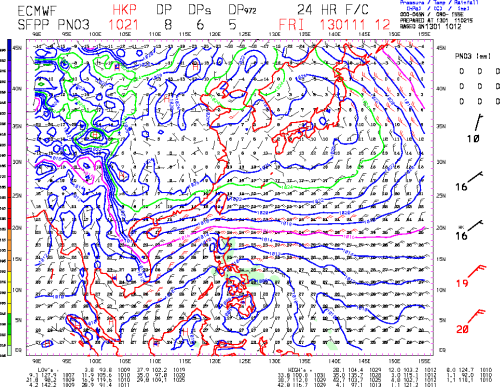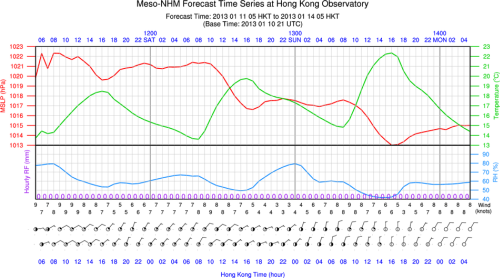Formulation of Weather Forecasts
Formulation of Weather Forecasts
LEE Kwok-lun
December 2012
We always hear some of our friends ask, "Isn't the Observatory using supercomputers to analyze weather data? Why can't they provide hundred percent accurate weather forecasts ?" In fact, a good weather forecast does not solely depend on the analysis of weather data by a supercomputer. A rigorous weather forecast has to be formulated based on knowledge in meteorology, accurate observations and simulation of weather processes. Moreover, the effect of other factors such as topography should also be taken into full account when making a weather forecast.
The weather at a place is mainly determined by the type of weather systems in its vicinity. In general, there are three main steps in formulating a weather forecast: (1) understand the current weather situation; (2) forecast the evolution of weather systems; (3) forecast the related weather elements. These three steps are elaborated as follows:
Understand current weather situation
The first step in making a weather forecast is the collection of meteorological observations. These include surface and upper air observation reports, readings from automatic weather stations such as air temperature, humidity, rainfall, etc from Hong Kong and other places in the world, as well as meteorological satellite and weather radar data. Forecasters need to analyze the latest weather data carefully and determine what weather systems and relevant mechanisms responsible for the current weather situation. During the analysis, the spatial and temporal distribution of various observed weather elements will be compared with those of typical weather systems. The purpose is to sieve through huge amount of data to determine the most likely weather system, such as cold front, trough or tropical cyclone, will affect the local weather.
Forecast evolution of weather system
Numerical weather prediction (NWP) products are widely used nowadays (Figure 1) in forecasting the evolution of weather systems. NWP is performed by using a computer to simulate the motion of air in the atmosphere. An NWP model is a suite of computer programs to simulate the atmospheric motions. Such a model incorporates different laws of Physics, including Newtons Laws, gas law, thermodynamics equations, fluid mechanics, etc. Different types of observational data are collected and analyzed to provide the initial conditions for the simulation. The model then simulates the evolution of the atmosphere including the future location and intensity of weather systems for the following time steps according to the laws of Physics. The simulation results will be presented as graphical forecast products to facilitate forecasters analysis and forecast of the development, dissipation, movement and intensity change of the weather systems.

Figure 1: Forecast chart of numerical weather prediction
Forecast related weather elements
Based on the NWP model outputs, forecast products for various weather elements can be generated such as in the form of a time series (Figure 2) for forecasters reference. Yet, NWP model outputs often suffer from bias. In general, such bias can be reduced using statistical method based on past performance of the NWP model. Even so, the modified model forecasts can still be biased. Weather forecasters will adjust various model forecast weather elements based on their experience and understanding of the weather systems and model characteristics to produce the final forecast.

Figure 2: NWP time series forecast of weather elements: including temperature, humidity, pressure, rainfall and cloud amount
It has to be emphasized that due to limitations of the current technology like insufficiency and errors of weather observations, incomplete understanding of atmospheric processes and limitations in computer simulation etc., it is impossible to have hundred percent accurate forecast of weather elements. Nevertheless, the Observatory will continue its research effort to further improve the accuracy of weather forecasts.